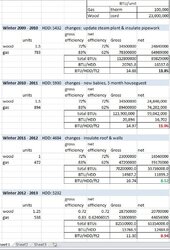No charts here. We began tracking when we filled the LP tanks as well as wood usage by the FC this year.
I can say this:
We have never heated with anything except wood here ourselves, HOWEVER the previous tenants used LP. When we got the LP company to remove their tank, the driver happened to be the same guy that used to fill it for the previous tenant. He said he filled it 2x per season. It was a 750ish gallon tank. LP runs the tankless hot water heater and cook stove, and at the time, an older boiler. We still use LP for HW and cooking, and last filled our 2 100lb tanks in June. We use the same HW tank, although the previous tenant was a single woman so we probably use more hot water since there are two of us. We use a different stove, the one that was here was a 1980's era hotpoint with electronic iginition, and we have a 1950's Floyd Wells Bengal with a standing pilot, so we probably use a bit more for that too. I'm not sure of conversion from gallons to pounds for LP, but I *think* each 100lb hold something like 35 gallons? I'm going to say that we use about 210 gallons, on the high side for HW and cooking, so I'm thinking the previous tenant used about 1300 gallons of LP for heat.
Now, for wood useage.
In year #1, we bought 8 FC and used about 40 packs of 8 ecobricks. Since this was bought wood, you can be assured it wasn't seasoned.
In year #2, we used about 3 FC hardwood that we bought the year before and stacked, about 15 left over packs of 8 ecobricks and we think about 5-6 FC of mixed misc wood like boxelder, willow and pine that was CSS the year before. MC was probably still above 20% because of where it had been stored but it was probably better than the wood in year #1.
Now we're into year #3. No left over ecobricks. Pretty much 80% Pine that was standing dead and CSS for a year. The other 20% is random mixed hardwood, box elder and willow. So far, we started burning shoulder season fires in October and regular fires in November. So far we've gone through 2 1/2 FC. We're figuring we'll burn about 7-9 FC a year of this type of wood.
The house hasn't changed too much since we bought it weather tightness wise. Windows and insulation are the same, except we removed two small casement windows and put in two 8' sliding glass doors. I'm going to say that's about even, the doors aren't triple pane but the windows weren't super either. We've reconfigured a laundry room this year so that is more part of the house than previously (it was just a little storage area that was closed off from the house by an exterior door), but it added only 50 sq ft max.
We now scrounge our wood, so the cost for the wood is in gas (vehicle/splitter/saws), upkeep on equipment, and depreciation on equipment. Kinda hard to figure.


 . Something w/ a cat, some soapstone, loooong burns (making sound like Homer thinking of donuts).
. Something w/ a cat, some soapstone, loooong burns (making sound like Homer thinking of donuts).
